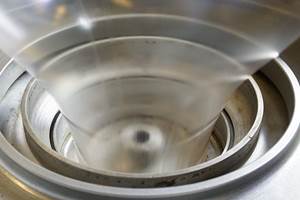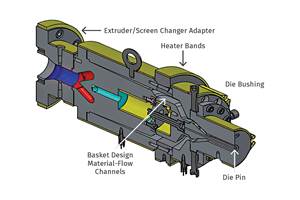Spartech Spreads "POP" Culture
“Continuous improvement” is not just a buzzword at Spartech Corp., the St.
“Continuous improvement” is not just a buzzword at Spartech Corp., the St. Louis-based compounder and sheet extruder. In the last four years, the multi-plant firm has cultivated cross-functional teams of five or more employees who work for a year toward improving a specific product, process, service, or relationship with a customer or vendor. These work groups are called POP teams for “Pyramids of Productivity.”
In 1998, the first year of the program, 38 Spartech plants fielded 24 teams. The next year, when Spartech required all plants to have at least two teams, 43 plants had 86 teams. By 2000, Spartech had grown through acquisition to 51 locations with 205 teams, an average of four per plant. Managers’ enthusiasm grew in proportion to the results the program generated.
How it started
The origin of POP was a program called QOS (Quality Operating System) at Preferred Plastic Sheet in Greenville, Ohio, a company Spartech bought in 1997. POP and QOS programs have similar goals, but QOS teams were ongoing, whereas POP teams have more defined lives and shorter-term goals. POP teams normally run from May to the following April. If they haven’t met their goals, they may run longer. “Sometimes teams aim for too much at once and bog down,” says David Gorenc, 911±¬ÁĎÍř manager of Spartech’s Muncie and Warsaw, Ind., plants. “We had a team last year that tried to reduce scrap generation but couldn’t because new products and more product changes got in the way. This year it’s our best team.”
POP is a structured program with written bylaws on how teams should be set up and run. For example, all teams must have a Champion or Facilitator who directs activities, a Recorder who keeps written records of decisions and duties, and a management Sponsor to approve the team’s goals and authorize resources to support them. Also, there must be a clear measure of success, such as cost savings or waste reduction.
Three tiers of winners
Intramural competition helps build morale. POP teams compete against other teams in their plant for the most impressive results. Winners at each plant are rewarded at the local level with a celebratory dinner and gift certificates. Plant winners then go to a two-day regional get-together of team Champions and plant managers. (Spartech has 12 regions.)
Each plant winner presents the team’s accomplishments to this regional peer group, which selects three to four regional winners. The group considers how much money a team saved the company, how hard the team worked, and how much data the team collected to support its work.
From the 40 or so regional winners, Spartech CEO Bradley B. Buechler and the company’s three executive vice presidents choose up to four national winners. These winners go to an annual three-day award meeting. Besides company-wide recognition, winners share a pool of stock options.
Team cross-pollination
“POP teams save the company millions of dollars a year,” says David Pocost, executive v.p. of extruded sheet and rollstock, who oversees the POP program. The teams’ work also brings intangible benefits of leadership training, motivation, and communication of company objectives.
Although improvements are measurable at the teams’ plants, Spartech has no mechanism yet to measure how winning ideas affect improvement at other plants. Buechler hopes the program will create a unifying culture of “best practices” for a company that has grown rapidly through acquisitions.
“The awards meeting is where we integrate beyond the regional level,” Buechler says. “We prepare a manual with the complete presentations of all the national winners. Attendees take that manual back to their own plants to implement the best practices there.” Spartech is also setting up an intranet where all POP-team projects and results will be posted.
Recognition has come from outside the company, too. Last year, a Muncie POP team won a trophy and $10,000 from the National Association of Manufacturers. That team saved Spartech $200,000 by cutting changeover time 50% on the company’s most complex sheet line, a five-layer coex line with EVOH and PVDC barrier layers.
Every employee in the Muncie plant got a share of that prize. What Spartech wants now is for everyone in the company to share in the ideas.
Related Content
Why Are There No 'Universal' Screws for All Polymers?
There’s a simple answer: Because all plastics are not the same.
Read MoreReduce Downtime and Scrap in the Blown Film Industry
The blown film sector now benefits from a tailored solution developed by Chem-Trend to preserve integrity of the bubble.
Read MoreHow to Select the Right Tooling for Pipe Extrusion
In pipe extrusion, selecting or building a complementary set of tooling often poses challenges due to a range of qualitative factors. Here’s some guidance to help you out.
Read MoreMedical Tubing: Use Simulation to Troubleshoot, Optimize Processing & Dies
Extrusion simulations can be useful in anticipating issues and running “what-if” scenarios to size extruders and design dies for extrusion projects. It should be used at early stages of any project to avoid trial and error and remaking tooling.
Read MoreRead Next
Lead the Conversation, Change the Conversation
Coverage of single-use plastics can be both misleading and demoralizing. Here are 10 tips for changing the perception of the plastics industry at your company and in your community.
Read MorePeople 4.0 – How to Get Buy-In from Your Staff for Industry 4.0 Systems
Implementing a production monitoring system as the foundation of a ‘smart factory’ is about integrating people with new technology as much as it is about integrating machines and computers. Here are tips from a company that has gone through the process.
Read MoreFor PLASTICS' CEO Seaholm, NPE to Shine Light on Sustainability Successes
With advocacy, communication and sustainability as three main pillars, Seaholm leads a trade association to NPE that ‘is more active today than we have ever been.’
Read More











